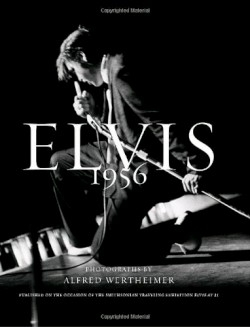Elvis 1956
- 2009 INDIES Winner
- Bronze, Music (Adult Nonfiction)
“We are passive onlookers in a world that moves perpetually. Our only moment of creation is that 1/125th of a second when the shutter clicks, the signal is given, and the motion is stopped.”[/i] —Henri Cartier-Bresson
Alfred Wertheimer was given a brief opportunity in 1956 to use his camera to make the life of Elvis Presley stand still at age twenty-one. He used that opportunity to create an everlasting portrait of Elvis at the dawn of his reign as “The King” and of America at the beginning of a new era.
Elvis 1956 is the pictorial story of the young singer on the cusp of unparalleled fame and fortune. It also is the story of America’s transition from the post-war era of the early 1950s to the tumultuous 1960s. Just as significantly, this book is a representation of the art of Alfred Wertheimer, then a young photojournalist.
Wertheimer’s photos are remarkable for their composition and technical excellence. He worked quickly under various and difficult lighting conditions, shooting in studios, onboard moving trains, and in the cavernous expanse of Grand Central Station. There are photos taken at night on dimly lit streets and in cafés with overhead neon lighting. A photograph of Elvis sitting at a lunch counter with a girlfriend puts the viewer in the doorway of that café. The image is quiet yet captivating in its detail. A tender sequence of three photos of Elvis giving an autograph to a young woman wearing a hat and white gloves ends with her overcome with emotion. The book’s final photo, taken on stage in Memphis under extraordinary lighting conditions, is powerful and electric.
Elvis is caught behind the scenes as he prepares for his early appearances on live television in New York City, first on the Dorsey Brothers’ Stage Show in March and later in the year on the Steve Allen Show. Other photos depict Elvis in commonplace settings and tasks: walking alone down a New York City street, checking into his hotel, and rehearsing for his television appearances. Wertheimer attended the legendary recording session at RCA on July 2, where Elvis recorded “Hound Dog” and “Don’t Be Cruel.” Each of these songs, separate sides of the same record, became number one hits. That feat had never before been accomplished, and no one has done it since.
Wertheimer also traveled with Elvis by train as he returned from New York to his home in Memphis. His photo of Elvis grabbing a bite to eat at a lunch cart on a railroad platform is particularly evocative of the period. The image of Elvis leaving the train alone in a Memphis suburb is remarkable, since this may have been the last time in his life Elvis was able to walk down a street alone and unrecognized.
These black and white photographs, neither staged nor rehearsed, reflect a moment in America that is black and white, too. Of the book’s fifty-six photos, only two include the faces of black Americans. In 1956, Elvis moved in a white world: his band and entourage were all white, and his fans were overwhelmingly white. Yet his music included and was influenced by the rhythm and blues and gospel of the southern black Americans amongst whom Elvis had grown up. Amy Henderson, a cultural historian who contributed an essay to the book, notes that Elvis bought his clothes in a men’s store in Memphis that was popular among black men of that city. Elvis was poised to take black culture to places where, because of segregation, no black man could take it.
While Elvis was busting out of the South onto the national scene, Wertheimer was also just beginning his career. The America these two men confronted was changing before their eyes. The photographs in this collection reflect a shared innocence, vibrancy, and expectation. The summer of 1956 was a mere two years after Brown vs. Board of Education, the US Supreme Court decision that declared “separate but equal” in schools unconstitutional. The times, they were a-changing, and changing quickly. Elvis and his music were both a part of and a cause of that change. Collectively, Wertheimer’s photos capture that time as if the photographer and his subject knew that the moment would not last.
Elvis 1956 will appeal to a broad segment of readers, including those who still carry a torch for Elvis, those interested in photography, and those with an interest in 1950s’America.
Disclosure: This article is not an endorsement, but a review. The publisher of this book provided free copies of the book to have their book reviewed by a professional reviewer. No fee was paid by the publisher for this review. Foreword Reviews only recommends books that we love. Foreword Magazine, Inc. is disclosing this in accordance with the Federal Trade Commission’s 16 CFR, Part 255.

